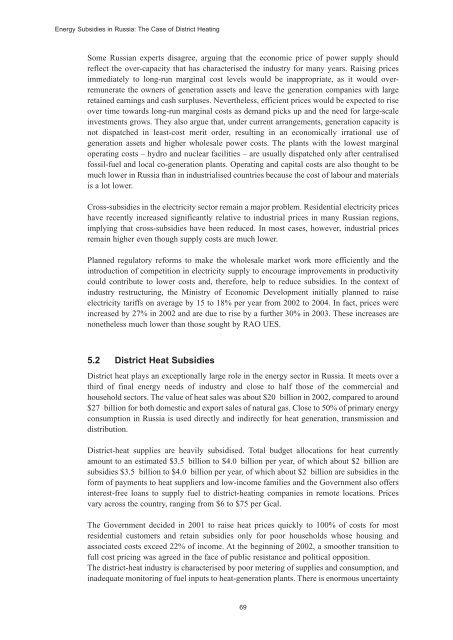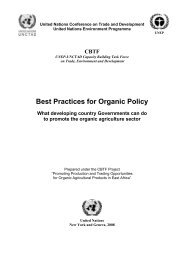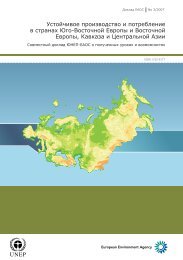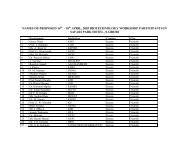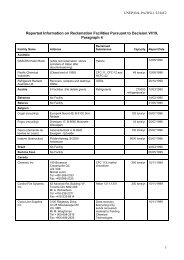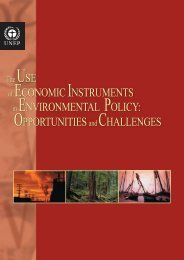Energy Subsidies: Lessons Learned in Assessing their Impact - UNEP
Energy Subsidies: Lessons Learned in Assessing their Impact - UNEP
Energy Subsidies: Lessons Learned in Assessing their Impact - UNEP
Create successful ePaper yourself
Turn your PDF publications into a flip-book with our unique Google optimized e-Paper software.
<strong>Energy</strong> <strong>Subsidies</strong> <strong>in</strong> Russia: The Case of District Heat<strong>in</strong>g<br />
Some Russian experts disagree, argu<strong>in</strong>g that the economic price of power supply should<br />
reflect the over-capacity that has characterised the <strong>in</strong>dustry for many years. Rais<strong>in</strong>g prices<br />
immediately to long-run marg<strong>in</strong>al cost levels would be <strong>in</strong>appropriate, as it would overremunerate<br />
the owners of generation assets and leave the generation companies with large<br />
reta<strong>in</strong>ed earn<strong>in</strong>gs and cash surpluses. Nevertheless, efficient prices would be expected to rise<br />
over time towards long-run marg<strong>in</strong>al costs as demand picks up and the need for large-scale<br />
<strong>in</strong>vestments grows. They also argue that, under current arrangements, generation capacity is<br />
not dispatched <strong>in</strong> least-cost merit order, result<strong>in</strong>g <strong>in</strong> an economically irrational use of<br />
generation assets and higher wholesale power costs. The plants with the lowest marg<strong>in</strong>al<br />
operat<strong>in</strong>g costs – hydro and nuclear facilities – are usually dispatched only after centralised<br />
fossil-fuel and local co-generation plants. Operat<strong>in</strong>g and capital costs are also thought to be<br />
much lower <strong>in</strong> Russia than <strong>in</strong> <strong>in</strong>dustrialised countries because the cost of labour and materials<br />
is a lot lower.<br />
Cross-subsidies <strong>in</strong> the electricity sector rema<strong>in</strong> a major problem. Residential electricity prices<br />
have recently <strong>in</strong>creased significantly relative to <strong>in</strong>dustrial prices <strong>in</strong> many Russian regions,<br />
imply<strong>in</strong>g that cross-subsidies have been reduced. In most cases, however, <strong>in</strong>dustrial prices<br />
rema<strong>in</strong> higher even though supply costs are much lower.<br />
Planned regulatory reforms to make the wholesale market work more efficiently and the<br />
<strong>in</strong>troduction of competition <strong>in</strong> electricity supply to encourage improvements <strong>in</strong> productivity<br />
could contribute to lower costs and, therefore, help to reduce subsidies. In the context of<br />
<strong>in</strong>dustry restructur<strong>in</strong>g, the M<strong>in</strong>istry of Economic Development <strong>in</strong>itially planned to raise<br />
electricity tariffs on average by 15 to 18% per year from 2002 to 2004. In fact, prices were<br />
<strong>in</strong>creased by 27% <strong>in</strong> 2002 and are due to rise by a further 30% <strong>in</strong> 2003. These <strong>in</strong>creases are<br />
nonetheless much lower than those sought by RAO UES.<br />
5.2 District Heat <strong>Subsidies</strong><br />
District heat plays an exceptionally large role <strong>in</strong> the energy sector <strong>in</strong> Russia. It meets over a<br />
third of f<strong>in</strong>al energy needs of <strong>in</strong>dustry and close to half those of the commercial and<br />
household sectors. The value of heat sales was about $20 billion <strong>in</strong> 2002, compared to around<br />
$27 billion for both domestic and export sales of natural gas. Close to 50% of primary energy<br />
consumption <strong>in</strong> Russia is used directly and <strong>in</strong>directly for heat generation, transmission and<br />
distribution.<br />
District-heat supplies are heavily subsidised. Total budget allocations for heat currently<br />
amount to an estimated $3.5 billion to $4.0 billion per year, of which about $2 billion are<br />
subsidies $3.5 billion to $4.0 billion per year, of which about $2 billion are subsidies <strong>in</strong> the<br />
form of payments to heat suppliers and low-<strong>in</strong>come families and the Government also offers<br />
<strong>in</strong>terest-free loans to supply fuel to district-heat<strong>in</strong>g companies <strong>in</strong> remote locations. Prices<br />
vary across the country, rang<strong>in</strong>g from $6 to $75 per Gcal.<br />
The Government decided <strong>in</strong> 2001 to raise heat prices quickly to 100% of costs for most<br />
residential customers and reta<strong>in</strong> subsidies only for poor households whose hous<strong>in</strong>g and<br />
associated costs exceed 22% of <strong>in</strong>come. At the beg<strong>in</strong>n<strong>in</strong>g of 2002, a smoother transition to<br />
full cost pric<strong>in</strong>g was agreed <strong>in</strong> the face of public resistance and political opposition.<br />
The district-heat <strong>in</strong>dustry is characterised by poor meter<strong>in</strong>g of supplies and consumption, and<br />
<strong>in</strong>adequate monitor<strong>in</strong>g of fuel <strong>in</strong>puts to heat-generation plants. There is enormous uncerta<strong>in</strong>ty<br />
69


